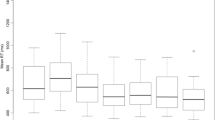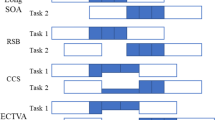Abstract
Participants presented with auditory, visual, or bi-sensory audio–visual stimuli in a speeded discrimination task, fail to respond to the auditory component of the bi-sensory trials significantly more often than they fail to respond to the visual component—a ‘visual dominance’ effect. The current study investigated further the sensory dominance phenomenon in all combinations of auditory, visual and haptic stimuli. We found a similar visual dominance effect also in bi-sensory trials of combined haptic–visual stimuli, but no bias towards either sensory modality in bi-sensory trials of haptic–auditory stimuli. When presented with tri-sensory trials of combined auditory–visual–haptic stimuli, participants made more errors of responding only to two corresponding sensory signals than errors of responding only to a single sensory modality, however, there were no biases towards either sensory modality (or sensory pairs) in the distribution of both types of errors (i.e. responding only to a single stimulus or to pairs of stimuli). These results suggest that while vision can dominate both the auditory and the haptic sensory modalities, it is limited to bi-sensory combinations in which the visual signal is combined with another single stimulus. However, in a tri-sensory combination when a visual signal is presented simultaneously with both the auditory and the haptic signals, the probability of missing two signals is much smaller than of missing only one signal and therefore the visual dominance disappears.



Similar content being viewed by others
References
Alais D, Burr D (2004) The ventriloquist effect results from near-optimal bimodal integration. Curr Biol 14(3):257–262
Botvinick M, Cohen J (1998) Rubber hand ‘feel’ touch that eyes see. Nature 391(6669):756
Bresciani JP, Dammeier F, Ernst MO (2008) Tri-modal integration of visual, tactile and auditory signals for the perception of sequences of events. Brain Res Bull 75(6):753–760
Bronson GW (1982) Structure, status, and characteristics of the nervous system at birth. In: Stratton P (ed) Psychobiology of the human newborn. Wiley, New York, pp 99–118
Bushnell MC, Weiss SJ (1977) The effect of reinforcement differences on choice and response distribution during stimulus compounding. J Exp Anal Behav 27(2):351–362
Colavita FB (1974) Human sensory dominance. Percept Psychophys 16(2):409–412
Colavita FB, Weisberg D (1979) A further investigation of visual dominance. Percept Psychophys 25(4):345–347
Colavita FB, Tomko R, Weisberg D (1976) Visual prepotency and eye orientation. Bull Psychon Soc 8:25–26
Delwiche J (2004) The impact of perceptual interactions on perceived flavor. Food Qual Prefer 15(2):137–146
Doyle MC, Snowden RJ (2001) Identification of visual stimuli is improved by accompanying auditory stimuli: the role of eye movements and sound location. Perception 30(7):795–810
Ernst MO, Bülthoff HH (2004) Merging the senses into a robust percept. Trends Cogn Sci 8(4):162–169
Ernst MO, Banks MS (2002) Humans integrate visual and haptic information in a statistically optimal fashion. Nature 415(6870):429–433
Farnè A, Pavani F, Meneghello F, Làdavas E (2000) Left tactile extinction following visual stimulation of a rubber hand. Brain 123(11):2350–2360
Forster B, Cavina-Pratesi C, Aglioti S, Berlucchi G (2002) Redundant target effect and intersensory facilitation from visual–tactile interactions in simple reaction time. Exp Brain Res 143(4):480–487
Fort A, Delpuech C, Pernier J, Giard MH (2002) Dynamics of cortico-subcortical cross-modal operations involved in audio–visual object detection in humans. Cereb Cortex 12(10):1031–1039
Gepshtein S, Burge J, Ernst MO, Banks MS (2005) The combination of vision and touch depends on spatial proximity. J Vis 5(11):1013–1023
Hecht D, Reiner M, Karni A (2008a) Enhancement of response times to bi- and tri-modal sensory stimuli during active movements. Exp Brain Res 185(4):655–665
Hecht D, Reiner M, Karni A (2008b) Multisensory enhancement: gains in choice and in simple response times. Exp Brain Res 189(2):133–143
Heller MA (1992) Haptic dominance in form perception: vision versus proprioception. Perception 21(5):655–660
Hershenson M (1962) Reaction time as a measure of intersensory facilitation. J Exp Psychol 63:289–293
Hoegg J, Alba JW (2007) Taste perception: more than meets the tongue. J Consum Res 33(4):490–498
Howard IP, Templeton WB (1966) Human spatial orientation. Wiley, New York
Hyman R (1953) Stimulus information as a determinant of reaction time. J Exp Psychol 45(3):188–196
Jane JA, Masterton RB, Diamond IT (1965) The function of the tectum for attention to auditory stimuli in the cat. J Comp Neurol 125(2):165–191
Koppen C, Spence C (2007a) Seeing the light: exploring the Colavita visual dominance effect. Exp Brain Res 180(4):737–754
Koppen C, Spence C (2007b) Spatial coincidence modulates the Colavita visual dominance effect. Neurosci Lett 417(2):107–111
Koppen C, Spence C (2007c) Assessing the role of stimulus probability on the Colavita visual dominance effect. Neurosci Lett 418(3):266–271
Koppen C, Alsius A, Spence C (2008) Semantic congruency and the Colavita visual dominance effect. Exp Brain Res 184(4):533–546
Körding KP (2007) Decision theory: what “should” the nervous system do? Science 318(5850):606–610
Körding KP, Beierholm U, Ma WJ, Quartz S, Tenenbaum JB, Shams L (2007) Causal inference in multisensory perception. PLoS ONE 2(9):e943
Kovacs G, Gulyas B, Savic I, Perrett DI, Cornwell RE, Little AC, Jones BC, Burt DM, Gal V, Vidnyanszky Z (2004) Smelling human sex hormone-like compounds affects face gender judgment of men. Neuroreport 15(8):1275–1277
Lewkowicz DJ (1988a) Sensory dominance in infants: I. Six-month-old infants’ response to auditory–visual compounds. Dev Psychol 24(2):155–171
Lewkowicz DJ (1988b) Sensory dominance in infants: II. Ten-month-old infants’ response to auditory–visual compounds. Dev Psychol 24(2):171–182
Liu WF, Laudert S, Perkins B, MacMillan-York E, Martin S, Graven S (2007) The development of potentially better practices to support the neurodevelopment of infants in the NICU. J Perinatol 27(Suppl 2):S48–S74
Meltzer D, Masaki MA (1973) Measures of stimulus control and stimulus dominance. Bull Psychon Soc 1:28–30
Miller L (1973) Compounding of discriminative stimuli that maintain responding on separate response levers. J Exp Anal Behav 20(1):57–69
Morrot G, Brochet F, Dubourdieu D (2001) The color of odors. Brain Lang 79(2):309–320
Oldfield RC (1971) The assessment and analysis of handedness: the Edinburgh inventory. Neuropsychologia 9(1):97–113
Pavani F, Spence C, Driver J (2000) Visual capture of touch: out-of-the-body experiences with rubber gloves. Psychol Sci 11(5):353–359
Pick HL, Warren DH, Hay JC (1969) Sensory conflict in judgments of spatial direction. Percept Psychophys 6:203–205
Randich A, Klein RM, LoLordo VM (1978) Visual dominance in the pigeon. J Exp Anal Behav 30(2):129–137
Recanzone GH (2003) Auditory influences on visual temporal rate perception. J Neurophysiol 89(2):1078–1093
Roth HA, Radle LJ, Gifford SR, Clydesdale FM (1988) Psychophysical relationships between perceived sweetness and color in lemon- and lime-flavored drinks. J Food Sci 53(4):1116–1119
Shams L, Kamitani Y, Shimojo S (2000) Illusions: what you see is what you hear. Nature 408(6814):788
Shams L, Kamitani Y, Shimojo S (2002) Visual illusion induced by sound. Brain Res Cogn Brain Res 14(1):147–152
Shams L, Kamitani Y, Shimojo S (2004) Modulation of visual perception by sound. In: Calvert G, Spence C, Stein B (eds) The handbook of multisensory processes. MIT Press, Cambridge, pp 27–33
Sinnett S, Spence C, Soto-Faraco S (2007) Visual dominance and attention: the Colavita effect revisited. Percept Psychophys 69(5):673–686
Welch RB, Warren DH (1980) Immediate perceptual response to intersensory discrepancy. Psychol Bull 88:638–667
Wickens CD (2002) Multiple resources and performance prediction. Theor Issues Ergon Sci 3(2):159–177
Wickens CD (2008) Multiple resources and mental workload. Hum Factors 50(3):449–455
Acknowledgments
This research was funded by the EU research project PRESENCCIA—Presence: Research Encompassing Sensory Enhancement, Neuroscience, Cerebral–Computer Interfaces and Applications. We thank Mr. Gad Halevy for programming the computer for the experiment.
Author information
Authors and Affiliations
Corresponding author
Rights and permissions
About this article
Cite this article
Hecht, D., Reiner, M. Sensory dominance in combinations of audio, visual and haptic stimuli. Exp Brain Res 193, 307–314 (2009). https://doi.org/10.1007/s00221-008-1626-z
Received:
Accepted:
Published:
Issue Date:
DOI: https://doi.org/10.1007/s00221-008-1626-z




